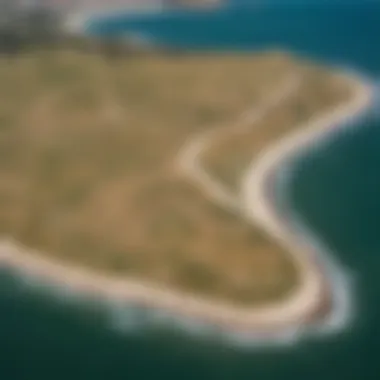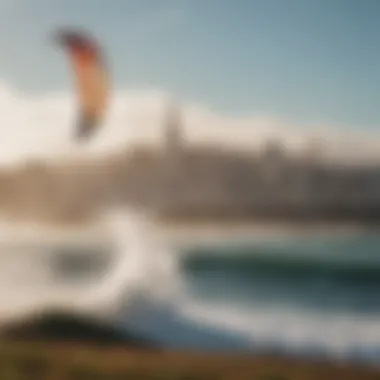Mastering San Francisco's Wind Patterns for Kiteboarding


Intro
Kiteboarding in San Francisco isn’t just a sport; it’s an art form that dances with the winds and spoils you with breathtaking views of the Bay and the Pacific Ocean. To truly embrace this exhilarating experience, one must have a firm grasp of the wind patterns unique to this city. Gaining insight into how geography, seasonal shifts, and the everyday whims of nature impact wind conditions is essential for kiteboarders of all skill levels. This article aims to decode the wind map of San Francisco, making it accessible to both novices and seasoned kiteboarding enthusiasts.
Understanding wind patterns can be somewhat like talking to a stubborn relative – sometimes unpredictable, sometimes predictable, and often requiring a bit of patience. The dialogue between the geography and climate of San Francisco creates a distinctive environment for kiteboarding, rich with opportunities and challenges. By the end of this guide, readers will have a clearer picture of how to navigate the impressive coastal breeze, understanding when to ride the wind and when to hold back.
Let’s dive into the wind map and start understanding what it means for our favorite water sport.
Prelude to Wind Mapping
When talking about kiteboarding, understanding the wind is like knowing the ropes. Wind mapping plays a crucial role in grasping the conditions that can make or break a day on the water. For kiteboarders in San Francisco, these maps are not just useful tools; they're the lifeblood of a successful ride. After all, predictin' the wind can be the difference between soaring high or being snagged on the beach like a fish on dry land.
Definition of Wind Mapping
So, what exactly is wind mapping? In simple terms, wind mapping involves creating visual representations of wind patterns in a specific area. These maps often use various colors and symbols to depict wind speed and direction, which can fluctuate significantly based on time of day and season.
An essential element of a wind map is its accuracy. This accuracy is garnered through the combination of meteorological data, historical weather patterns, and real-time observations. Therefore, when kiteboarders look at a wind map, they are observing a synthesis of data that speaks to the conditions of the air around them. It’s like having a GPS, but for wind—navigational charts that can guide you toward the best kiteboarding spots.
Importance of Wind Maps in Kiteboarding
Wind maps hold immense significance for enthusiasts who take to the skies over water. Here are key points that underline their importance:
- Safety First: Wind can change in the blink of an eye. Understanding current wind conditions lowers the risk of accidents or equipment damage while kiteboarding, helping both novices and veterans to enjoy the sport without a cloud of worry hanging overhead.
- Optimize Your Time: With the right information at your fingertips, kiteboarders can plan trips for maximum fun. No one wants to spend hours waiting for a breeze that may never show up, right? Knowing where and when to go makes all the difference.
- Enhanced Performance: When you know the wind patterns, you can adjust your technique accordingly. Whether it's adjusting sail size or changing your riding style, being well-informed means you can fly through the air like a pro.
- Localized Insights: Different parts of San Francisco offer varied wind conditions. Utilizing wind maps helps kiteboarders discover which spots are favorable in real-time, allowing them to chase the best conditions throughout the city.
Ultimately, wind mapping is about empowerment. It gives kiteboarders the tools they need to make informed decisions, ensuring a more rewarding and enjoyable experience out on the waves. As we dive deeper into the wind patterns of San Francisco, these maps will be the compass guiding us along the way.
Geographical Overview of San Francisco
San Francisco's geography plays a pivotal role in shaping its wind patterns, which in turn affects kiteboarding conditions throughout the Bay Area. Understanding these geographical nuances allows kiteboarders to make informed decisions about when and where to ride the waves. Moreover, it can also help in planning sessions that maximize enjoyment while minimizing hazards, making it a necessity for anyone serious about the sport.
Bay Area Topography
The Bay Area's topographical features are quite diverse, contributing to the wind dynamics in the region. The presence of hills, valleys, and, of course, the iconic Golden Gate also come into play when assessing wind behavior. The coastal mountains can act as barriers, channeling the wind in specific directions, or sometimes even blocking it altogether.
- Hills and Valleys: The rolling hills, like Twin Peaks and Mount Sutro, create microclimates that can significantly influence wind conditions in nearby fields. Valleys often funnel wind into more intense flow patterns, while higher elevations provide a different experience altogether.
- Coastline Shape: With beaches and cliffs lining the coast, locations like Crissy Field and Ocean Beach present varying conditions, which can drastically change with the tide and time of day.
In essence, it's vital for kiteboarders to understand how these topographical features interact with the winds to identify the best spots for kiteboarding. Awareness of these factors can mean the difference between a mediocre session and one that feels truly exhilarating.
Influence of Ocean Currents
The ocean currents off San Francisco’s coast also have an impact on wind patterns. The flow of water can affect local meteorological conditions, which are critical for kiteboarding enthusiasts.
- California Current: This major cold-water current flows southward along the coast. It can lead to cooler air temperatures, influencing thermal winds which many kiteboarders rely on for steady winds.
- Inland Heat: On days where inland areas heat up more quickly than the ocean, the sea breeze kicks in, creating ideal conditions for kiteboarding. This is particularly useful during the hotter summer months when kiteboarders flock to the bay.
Moreover, the mixing of warmer and cooler air can lead to varying wind strengths and directions, making it paramount to check not just wind maps, but also current patterns before heading out.
"Understanding the geographical landscape and ocean influences can empower kiteboarders to choose conditions that truly suit their skill level and enhances their overall experience."
For kiteboarders in and around San Francisco, a thorough grasp of how local topography and ocean currents interact with wind can be the key to elevating their ride—turning the kiteboarding experience from just fun into a thrilling adventure.
Characteristics of San Francisco Winds
Understanding the characteristics of winds in San Francisco is pivotal for anyone looking to kiteboard in these waters. The wind behavior here isn’t just a fleeting aspect; it's a vital component that dictates the experience every time a kite is unfurled. By recognizing this intricate dance of seasonal shifts, daily cycles, and local variations, kiteboarders can anticipate conditions, enhance safety, and maximize their fun on the water.
Seasonal Wind Patterns
San Francisco experiences pronounced seasonal winds that kiteboarders must consider. During summer, the wind patterns tend to be robust and consistent, primarily due to the coastal temperature gradients. This is when warm land heats up, creating low-pressure areas that draw in cooler air from the Pacific Ocean. As a result, kiteboarders can expect wind speeds commonly ranging from 15 to 25 knots, perfect for an exhilarating ride.


Conversely, during winter, the wind seems to play a waiting game. While there are still breezy days, the winds can be more erratic and are often affected by winter storms. The fierce storms from the west can produce strong gusts, but they aren’t reliable, making kiteboarding a bit of a gamble at that time. Understanding these seasonal shifts can profoundly affect how one approaches their kiteboarding sessions.
Diurnal Wind Cycle
The diurnal wind cycle in San Francisco adds another layer to the wind behavior puzzle. Usually, a pattern emerges with the winds picking up when the sun begins to rise higher in the sky. It's not uncommon for those mornings to start off under calm conditions with light breezes due to the cool morning air. However, as temperatures rise throughout the day, the winds start to pick up, typically reaching their peak in the afternoon before tapering off again as the sun sets.
Kiteboarders often find that planning their sessions around this diurnal cycle can lead to a more enjoyable outing. For instance, heading out during those mid-afternoon hours when wind speeds are at their peak can make all the difference in harnessing that powerful ocean breeze.
Microclimates and Wind Variations
Diving deeper into the local geography, microclimates around the Bay Area significantly influence the wind. San Francisco is home to a myriad of neighborhoods, and each can present unique wind conditions. For instance, places like the Marina or Ocean Beach experience distinctly different wind patterns than spots near the Golden Gate.
These variations are critical for kiteboarders to grasp. When choosing where to launch, factors such as local topography, nearby buildings, and the presence of natural barriers can alter wind speed and direction dramatically.
"The winds of San Francisco are as complex as the city's famous fog—unpredictable and ever-changing. Understanding these subtleties is essential for every kiteboarder."
For an informed kiteboarding experience, recognizing these microclimates ensures that you pick the best spot for your adventure. Many seasoned kiteboarders share updates and personal experiences on forums like Reddit, offering invaluable insights on specific areas, which can wealthily inform your next kiteboarding session in this captivating region.
Equipped with this in-depth understanding of seasonal patterns, diurnal cycles, and the effect of microclimates on wind variations, kiteboarders can navigate the winds of San Francisco with a greater sense of mastery, ensuring memorable experiences on the water.
Wind Speed and Direction Analysis
Understanding the nuances of wind speed and direction is paramount for kiteboarding enthusiasts, especially those navigating the unique conditions of San Francisco's diverse coastline. Kiteboarding, while a thrilling sport, hinges significantly on wind conditions. Knowing how to interpret wind speed and direction can mean the difference between a seamless ride and an unexpected tumble into the water.
Understanding Wind Speed Measurements
Wind speed is often measured in knots or miles per hour, but kiteboarders must grasp what these figures translate to in practical terms. Winds of around 10 to 20 knots provide a sweet spot for most kiteboarders, giving enough power to soar without being overly daunting.
Many kiteboarders rely on tools like anemometers, which measure wind speed directly. Additionally, wind speed measurements can be accessed from various online weather cservices, offering real-time data. However, it’s critical to remember that wind speed may vary significantly within short distances, especially in an area with varied topography like San Francisco.
- Be mindful of local weather stations: They can provide forecasts that are not just accurate but also tailored to specific kiteboarding locations in the San Francisco Bay Area.
- Look for wind speed trends: Understanding how wind speeds fluctuate throughout the day can help kiteboarders choose the best time for hitting the water. Use of historical data might showcase patterns, assisting experienced riders as well as newcomers.
Determining Wind Direction for Kiteboarding
Wind direction is another crucial element to consider while kiteboarding. It is typically reported in degrees, with 0 degrees being north. Kiteboarding enthusiasts should look for directional wind patterns that align with their chosen riding spots.
A southwest wind is especially favored in San Francisco, as it often results in ideal kiteboarding conditions at many local spots like Crissy Field. This wind direction not only affects the intensity but also has implications on potential obstacles, including land formations and bodies of water that can alter wind flow.
To determine wind direction effectively:
- Check forecasts for wind direction before heading out. Use wind direction indicators on weather apps or websites to glean accurate data.
- Observe the behavior of flags, trees, or even kites already in the air. If the flags are flapping southward, it's likely that the breeze is in your favor for a good time on the water.
"The wind holds the secret to a great kiteboarding session; understanding it can lead to a day filled with exhilaration rather than frustration."
Utilizing Wind Maps for Kiteboarding
The use of wind maps is critical for kiteboarding enthusiasts navigating the often unpredictable breezes of San Francisco’s coastline. Understanding these maps offers kiteboarders a wealth of knowledge that goes beyond mere enjoyment; it ensures safety and maximizes the experience on the water. By harnessing the information provided by wind maps, kiteboarders can not only forecast conditions but also make informed decisions about when and where to launch.
Reading and Interpreting Wind Maps
Navigating the sea of information in wind maps can be daunting for the untrained eye. However, once you’ve familiarized yourself with key symbols and notations, these maps transform into powerful tools rather than mere graphics on a screen.
- Wind Speed Indicators: Understanding the various colors and markings that depict wind speed is essential. For instance, shades of blue typically indicate lighter winds, while stronger winds are represented by deeper hues, such as reds and purples. This color-coded system allows kiteboarders to quickly gauge whether conditions are favorable.
- Wind Direction Arrows: These arrows guide you in determining from where the wind is blowing. The tail of the arrow shows the originating direction, while the pointed end indicates the wind's path. Noting wind direction is crucial for deciding where to strategically place your kite for optimal lift and performance.
- Isobars: These lines connect points of equal pressure on the map. Close isobars indicate strong wind gradients, meaning stronger winds. If you're targeting a particular kiteboarding spot, observing proximity to these lines can help you decide the best time for an outing.
- Time Frames: Many wind maps provide forecasts for short, medium, and long-term periods. Checking these different time frames can inform whether it’s better to kiteboard in the morning when the winds might be calmer or wait for the mid-afternoon when gusts can pick up.
Reading wind maps actively enables kiteboarders to visualize the wind patterns and make more knowledgeable choices.
Practical Applications of Wind Maps
Once you can read wind maps effectively, the next step is applying that knowledge in real-world kiteboarding scenarios. Here are a few practical uses for wind maps:


- Choosing the Right Location: Different spots around San Francisco, like Crissy Field and Ocean Beach, possess their own unique wind characteristics. By analyzing a wind map, you can identify which site will provide the conditions that match your skill level and kiteboarding style. For example, if a map predicts consistent offshore winds at one location but turbulent crosswinds at another, you know where not to go.
- Timing Your Session: Wind maps aren't just about location; they help with timing as well. If you see that wind conditions will shift throughout the day, you might plan your session for a specific time when the wind is anticipated to be at its best. This insight can be the difference between a stellar session and battling against too little or too much wind.
- Planning for Safety: Basing your outing on actual data from wind maps allows you to assess any potential hazards. Kiteboarding in strong winds can be dangerous, especially for less experienced riders. Wind maps revealing predictions for gusty conditions can prompt you to postpone your session until conditions are more favorable.
"A wise kiteboarder reads the wind well, for it gives them the keys to both adventure and safety on the water."
- Engaging with Local Community Reports: Many kiteboarding spots have local forums or community groups where enthusiasts share their experiences and insights related to wind patterns. Combining these personal reports with wind map data can enhance your understanding of conditions you may face, especially if you're new to the area. Checking sites like reddit.com or facebook.com groups dedicated to kiteboarding can provide invaluable real-time insights.
In summary, wind maps serve as essential companions for kiteboarders. Mastering the art of interpreting them fundamentally alters how you approach the sport. With maps in hand, riding the winds of San Francisco becomes a more strategic and rewarding endeavor.
Common Kiteboarding Spots in San Francisco
Kiteboarding in San Francisco is not just a pastime; it’s an experience molded by the unique characteristics of its coastal winds and varied locations. Having a good grasp of where to kiteboard is crucial for a number of reasons. First and foremost, certain spots provide optimal wind conditions that maximize both performance and safety. Moreover, local knowledge can help in recognizing hazards and suitable launch areas, reducing risks of injury or equipment damage.
This section will explore the most popular kiteboarding spots in San Francisco, providing insights into their specific conditions, facilities, and other considerations. Understanding these areas can significantly influence a kiteboarder’s enjoyment and skill development.
Overview of Popular Locations
San Francisco is blessed with several prime kiteboarding locations, each with its own distinct strengths and weaknesses. Here’s a closer look at some of these places:
- Crissy Field: Situated in the Presidio, this spot is a favorite among both beginners and experienced riders. The sandy beach is flanked by stunning views of the Golden Gate Bridge, and the consistent winds create a playground for kiteboarders. However, with heavy traffic from beginner lessons, awareness is vital for safety.
- Fort Point: Known for its reliable winds and stunning backdrop of the Golden Gate Bridge, Fort Point offers advanced kiteboarders a chance to harness powerful winds. Here the surf can sometimes be challenging, so experience in handling varying sea conditions is important.
- Baker Beach: A more relaxed atmosphere characterizes Baker Beach. It’s less crowded, providing ample space for kiters, especially during weekdays. However, kiteboarders should note that the wind can be unpredictable here, particularly in the morning.
- Lands End: This hidden gem is often overlooked but is ideal for those seeking a quieter experience. The winds here can be less consistent, making it best for more skilled kiteboarders who can navigate the variability.
- Ocean Beach: A spot for the seasoned kiteboarders, Ocean Beach can be a thrill ride due to its strong, crashing waves and high winds. Caution and awareness of strong currents are essential for anyone looking to tackle this locale.
Comparative Wind Conditions at Each Spot
Understanding the differing wind conditions across these kiteboarding hotspots is vital. Here’s how each location lines up:
- Crissy Field: Wind speeds usually hover around 15-25 knots during the summer, making it ideal for kiteboarding. Winds tend to be more consistent due to the funneling effect created by the landscape.
- Fort Point: This spot can experience stronger gusts, often exceeding 25 knots during the peak. It’s crucial to have experience in managing high wind conditions and navigating strong currents as well.
- Baker Beach: Wind speeds can vary significantly. During the summer, they can range from 10 knots to 20 knots, often changing quickly. Therefore, kiteboarders need to be vigilant of shifting conditions.
- Lands End: Winds here can be fickle. Ranging from 8 knots to 20 knots, those seeking to kiteboard must be adaptable and alert to real-time changes in weather conditions.
- Ocean Beach: The most exhilarating yet challenging conditions can be found here, with wind speeds often hitting 20-30 knots. It's crucial for riders to have a strong grasp of their skill level and equipment to safely enjoy the strong winds and waves.
Understanding the wind conditions at each spot is essential for keeping safety at the forefront while maximizing enjoyment.
Armed with this insight into kiteboarding locations and their respective wind conditions in San Francisco, riders can make informed choices about where to practice and enjoy their time on the water.
Safety Considerations While Kiteboarding
When it comes to kiteboarding, safety isn’t just a luxury; it’s an absolute necessity. Understanding the various safety considerations can make a world of difference, especially in a dynamic environment like San Francisco where wind patterns are unpredictable. Prioritize safety measures and be aware of potential risks that can arise on the water. Having this knowledge not only protects you but also enhances your overall kiteboarding experience.
Assessing Wind Conditions
Before you even think about hitting the water, assessing wind conditions should be your first order of business. Different winds can transform an ideal kiteboarding day into a nightmare in the blink of an eye. Here are a few crucial aspects to consider when evaluating wind conditions:
- Wind Speed: Familiarize yourself with the Beaufort scale, which provides a clear perspective on how wind speeds translate into conditions on the water. A light breeze (1 to 15 knots) may feel enticing, but higher speeds (above 25 knots) can create hazardous conditions.
- Wind Direction: Knowing where the wind is coming from is crucial. Cross-shore winds can be fun, but they can also lead to tricky situations where you might get blown away from the safe zones. On the flip side, off-shore winds can be deadly when you are pushed far from the shore.
- Changes in Weather: Keep a close eye on the weather forecast. Sudden changes can sneak up on you, affecting both wind speed and direction at any moment. A perfect morning can turn into a stormy afternoon quicker than you think.
When you are out there, continuously reevaluate these factors. Adjustments might be necessary as conditions change, so stay sharp and do not let complacency creep in.
Emergency Procedures in High Winds
Even with the best precautions, situations can escalate in a heartbeat. Knowing what to do in emergencies is vital for both your safety and that of others. Here are some key procedures to follow if high wind conditions catch you off guard:
- Release the Safety Line: If you ever feel overpowered, mastering the quick release for your safety line could save your life. This action detaches the kite, allowing you to float until you can regain control.
- Signal for Help: If you find yourself struggling, shouting or waving your arms can alert nearby kiteboarders or lifeguards. Don’t be shy about asking for assistance—better safe than sorry.
- Use Your Board as a Safety Aid: If winds are too strong, use your board to stabilize yourself in the water. This helps prevent being whipped around or pulled underwater.
- Seek Shelter: If you find yourself in an uncontrollable situation, steer yourself towards the shore or any nearby boats. Breaks or sheltered areas can provide a safe haven until the winds die down.
"Preparation is the key to success. Knowing how to react can make the difference between a close call and a disaster."
Impact of Climate Change on Wind Patterns
Climate change affects many aspects of our environment, and the wind patterns in San Francisco are no exception. For kiteboarders, understanding these changes is crucial not only for safety but also for enhancing their overall riding experience. When we talk about wind patterns in the context of kiteboarding, we must consider how climate change modifies wind behaviors over time, what those transformations mean for water sports, and the techniques needed to cope with them.
Long-term Trends in Wind Behavior
Over the years, studies have pointed out changes in wind speeds and directions, especially during the summer months when the sea breezes are supposed to be at their peak. The winds that once reliably rushed in from the Pacific are showing signs of inconsistency. For instance, kiteboarders might notice days when the expected strong winds seem to be taking a vacation. This keeps everyone guessing, and for someone trying to navigate their way through the intricate world of kiteboarding, it can challenge even the most seasoned pro.


Some notable long-term trends include:
- Decreased Predictability: The once steady wind patterns have started to show variability, making it difficult to plan outings.
- Fluctuating Wind Speeds: Kiteboarders have reported that winds vary more widely than in previous years, leading to conditions that can swing from too tame to dangerously gusty in a matter of hours.
- Shifts in Seasonal Wind Peaks: Traditionally, summer brought consistent winds, but some studies indicate a significant shift in these patterns, with winds not aligning with typical seasonal expectations.
These trends signal to kiteboarders that a more flexible approach to planning is necessary. Understanding the why behind these shifts becomes essential when selecting the time and location for kiteboarding.
Future Implications for Kiteboarding
As climate conditions continue to evolve, kiteboarding enthusiasts must stay keenly aware of its potential implications. Here are a few considerations that kiteboarders should make down the line:
- Adapt to New Norms: Kiteboarders will need to study and adapt to the new wind patterns; this might require them to tune their techniques and gear in ways they would have considered unnecessary before.
- Safety Precautions: Just as kiteboarders prepare for specific wind conditions, they should also develop a broader understanding of changing weather systems to better assess risks and safety.
- Altered Location Favorites: Some kiteboarding spots known for ideal winds might become less reliable. Adventure-seekers may need to explore new areas or even consider times of day when the winds are more favorable.
"The winds may be changing, but that doesn't mean we can’t learn to ride the new currents. Adjusting and adapting is key to our success and safety on the water."
With these long-term trends and potential implications in mind, kiteboarders can navigate the tricky waters of a warming climate and still enjoy the thrill they seek in San Francisco's diverse scenery. It's about adjusting strategies, keeping an eye on new weather patterns, and preparing for the adventures that lie ahead.
Community Insights on Kiteboarding Conditions
Gaining insights from the local kiteboarding community adds layers of knowledge that go beyond what wind maps and forecasts can provide. While maps show patterns and predictions, the voices of experienced kiteboarders paint a picture grounded in experience and personal anecdotes. These insights are invaluable for anyone seeking to navigate the sometimes fickle winds of San Francisco, where subtle nuances can make all the difference.
Fostering connections with the community blends both social and practical know-how. Understanding local kiteboarder perspectives helps newcomers acclimate to the area faster. Those who’ve spent countless hours on the waves often notice details that maps might overlook—like how wind can funnel between buildings or the presence of persistent gusts in specific areas. This holistic approach allows kiteboarders of all skill levels to better anticipate conditions, ultimately enhancing safety and enjoyment.
Local Kiteboarder Perspectives
When it comes down to it, chatting with local kiteboarders can provide insights you wouldn’t find anywhere else. Their perspectives are like gold; years of riding these winds gives them an edge in understanding the ever-changing nature of kiteboarding conditions. For instance, seasoned locals often talk about how the fog rolls in, affecting both wind speed and direction. Some might share tips on when to hit the water—like that magical period shortly after noon when thermals kick in, providing a stronger, more consistent wind.
- First-hand experiences: Local stories about near-perfect conditions at a lesser-known spot can open doors to new adventures.
- Safety tips: New kiteboarders can learn about potential hazards, such as rocks or submerged debris, that newbie maps might miss.
These real-life experiences serve as a guide for adjusting to the unique conditions of San Francisco’s kiteboarding spots. The rewards of such connections are plentiful; riders often find mentorship and camaraderie, enhancing both their skills and their enjoyment on the water.
User-generated Wind Reports
User-generated wind reports share on-the-ground updates that traditional wind forecasts simply cannot replicate. Platforms like Reddit become hotspots for kiteboarders to share real-time information about wind conditions. These types of communities thrive on the immediacy of interaction, allowing kiteboarders to post live updates, share observations, and ask questions.
- Current conditions: Riders post about wind speed, direction, and site-specific nuances. This live feedback can prove essential for planning trips.
- Community forums: Discussions around gear, technique, or safety contribute to a wealth of communal knowledge that transcends individual experience.
Utilizing such reports not only keeps kiteboarders informed but also helps unite the community. Sharing experiences fosters trust and builds relationships among kiteboarders, further enriching the overall adventure. These collective insights can often lead to discovering hidden gems where waves are less crowded, or conditions are just right for an exhilarating ride.
In summary, community insights around kiteboarding conditions provide kiteboarders with a nuanced understanding that complements wind maps. Scouring the local landscape for perspectives and user-generated reports unfolds avenues for safer, more enjoyable kiteboarding experiences, making it an essential part of preparation.
"No map can capture the heartbeat of the wind as well as the tales of those who ride it daily."
Joining and participating in these communal exchanges not only arms kiteboarders with knowledge but also enhances the social fabric of the kiteboarding scene in San Francisco.
Culmination: Mastering San Francisco Winds
Concluding our exploration of San Francisco's winds, it’s clear that understanding these unpredictable elements is pivotal for kiteboarders. Kiteboarding isn’t just a whimsical pastime; it's a sport that demands environmental acumen.
Wind conditions can change faster than a New York minute. This article sheds light on how both novices and veterans can adapt and thrive in these unique coastal environments. Whether you're gliding through the waves at Crissy Field or testing your skills at Ocean Beach, mastering wind patterns can genuinely elevate your kiteboarding experience.
Summarizing Key Takeaways
As we digest the information shared, a few critical points resonate strongly:
- Know the Local Terrain: San Francisco's geography dictates wind behavior. Recognizing landmarks and topographical quirks can help kiteboarders make sense of gusty conditions.
- Embrace Seasonal Changes: Winds in the Bay area aren’t static. Different seasons bring distinct patterns that can enhance or hinder your ride. Be aware of seasonal shifts to maximize performance.
- Leverage Wind Maps: Familiarity with wind maps isn’t just an academic exercise; it’s a practical tool. Learning to read these maps allows kitesurfers to plan their outings, ensuring safety and enjoyment.
- Community Matters: Engaging with local kiteboarding communities can yield invaluable insights. Observations and experiences shared by fellow kiteboarders can guide your learning curve, making for a safer sports environment.
When you grasp these elements, you're more positioned to navigate the whims of San Francisco's winds effectively.
Encouragement for Continued Learning
The journey of understanding kiteboarding winds doesn’t stop here. Opportunities for growth and improvement abound, and staying informed is your best strategy. Consider the following approaches to deepen your knowledge:
- Join Workshops or Clinics: Participating in local workshops can connect you with experts. These sessions often cover the latest in wind behavior, gear optimization, and safety practices.
- Follow Online Forums: Engaging in discussions on platforms like Reddit or Facebook can expand your perspective. You’ll find seasoned kiteboarders willing to share their tricks of the trade.
- Take Up Wind Analysis Tools: Investing in tools or apps that provide real-time wind data can improve your ability to read conditions accurately. Consider options that aggregate wind forecasts for better predictive understanding.
- Experiment and Reflect: The waters off San Francisco are a dynamic training ground. Your individual experiences will teach you the most about how to adapt to varying conditions.
No matter where you are on your kiteboarding path, remember that wind is not just a backdrop; it’s an active participant in your ride. Keep learning, practicing, and engaging with the community – mastery lies in continuous improvement and a passionate commitment to the sport.















